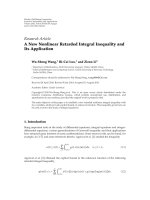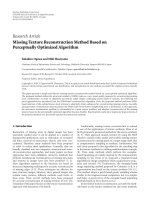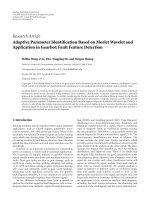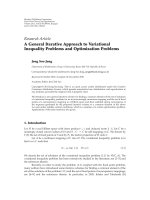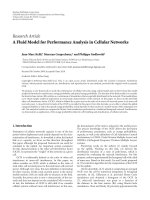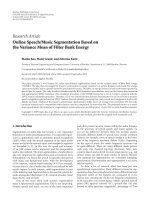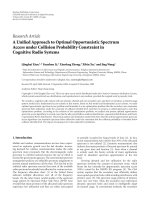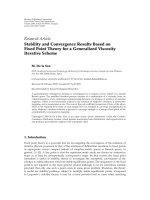Báo cáo hóa học: " Research Article A Skin Detection Approach Based on Color Distance Map" doc
Bạn đang xem bản rút gọn của tài liệu. Xem và tải ngay bản đầy đủ của tài liệu tại đây (1.58 MB, 10 trang )
Hindawi Publishing Corporation
EURASIP Journal on Advances in Signal Processing
Volume 2008, Article ID 814283, 10 pages
doi:10.1155/2008/814283
Research Article
A Skin Detection Approach Based on Color Distance Map
M. Abdullah-Al-Wadud,
1
Mohammad Shoyaib,
2
and Oksam Chae
2
1
School of Industrial and Management Engineering, Hankuk University of Foreign Studies, 89 Wangsan, Mohyun,
Cheoin, Yongin 449-791, South Korea
2
Department of Computer Engineering, Kyung Hee University, 1 Seocheon, Kiheung, Yongin 449 701, South Korea
Correspondence should be addressed to Oksam Chae,
Received 10 March 2008; Revised 20 August 2008; Accepted 16 December 2008
Recommended by Moon Kang
We propose a reliable approach to detect skin regions that can be used in various human-related image processing applications. We
use a color distance map, which itself is a grayscale image making the process simple, but still containing color information. Based
on this map, we generate some skin as well as nonskin seed pixels, and then grow them to capture the appropriate regions. This
approach outperforms the existing approaches in terms of segmenting solid and perfect skin regions. It does not generate much
noisy segments. Moreover, it does not need any prior training session and can adapt to detect skin regions from images taken at
different imaging conditions.
Copyright © 2008 M. Abdullah-Al-Wadud et al. This is an open access article distributed under the Creative Commons
Attribution License, which permits unrestricted use, distribution, and reproduction in any medium, provided the original work is
properly cited.
1. INTRODUCTION
Skin segmentation is a major component in human-
computer interaction- (HCI-) based applications such as
gesture analysis, facial expression detection, face tracking,
human motion tracking, and other human-related image
processing applications in computer vision and multimedia
such as filtering of web contents, retrieving in multimedia
databases, video surveillance, videophone, and videoconfer-
encing applications.
The main target of skin detection is to detect skin pixels
in images and thereby generate some skin regions. These
regions are then further investigated according to the focus
of the specific application. A successful recognition of skin
regions eases subsequent parts of a system those do the
detail processing of such regions. If candidate regions are
erroneously detected, then a good amount of effort by the
application will be used in unsuccessful diagnosis. Further,
if the detection process misses any skin region or provides
regions having lots of holes in it, then the reliability of
applications will also decrease. Hence, this initial step should
be made sufficiently reliable to maintain the efficiency of the
systems those depend on it.
Many different skin detection approaches have been
proposed in the literature over the past few years. However,
the performance of most of the approaches is satisfactory
for a limited set of real world conditions and skin types
only [1]. Early approaches of skin segmentation deal with
grayscale images. However, these approaches suffer from
inappropriate detections as well as the rejections of skin
pixels since grayscale images lack the appropriate variation
in color.
Recently, skin detection methodologies based on color
information have gained much attention since skin color
provides computationally effective and robust information
against rotations, scaling, and partial occlusions [1]. Hence,
color may serve as a very effective tool for identifying
skin areas if the skin color pixels can be represented,
modeled, and classified accurately. However, real world skin
detection can be a challenging task, as the skin appearance
in images is affected by various factors. For example,
different illumination levels like indoor, outdoor, highlights,
shadows, and so forth. may cause change in skin color
(color consistency problem [1]). Skin color of the same
person in same illumination condition may differ in different
images taken by cameras having different characteristics like
spectral reflectance, sensor sensitivities, and so forth. Skin
color also differs for different persons coming from different
ethnic groups [2]. Some individual characteristics such as
age, sex, and body parts also affect the appearance of skin
2 EURASIP Journal on Advances in Signal Processing
color [1]. Some other reasons may also make changes in skin
color such as subject appearances (makeup, hairstyle, and
glasses), background colors, and motions. Efforts have been
given to minimize the effect of these factors, especially to
normalize the color, so that the image is less sensitive to the
illumination. Several approaches are proposed to make use of
color space transformation [3–6]orratiosofdifferent color
channels [7, 8]. However, most of the transformed spaces
that deal with chrominance and some color information
are also lost in the process of separating luminance from
chrominance.
We may categorize the existing methods for classifying
skin and nonskin pixels into three broad categories: paramet-
ric, nonparametric, and explicit threshold-based skin cluster
classifiers [1, 9]. In parametric methods, single/Gaussian
mixture models [1] are used to model the skin color
distribution in different color spaces. For example, in [10],
skin color distribution is modeled by an elliptical Gaussian
joint probability density function. Mixture of Gaussian
(MoG) [11] models is composed as sum of some Gaussian
kernels. However, the classification speed of MoG is very slow
asitevaluateseachofthesekernelsforeverypixel.Itisvery
slow in training phase as well [12]. Moreover, it also suffers
from inaccuracy as it has to depend on the approximated
parameters instead of the actual distribution of skin colors.
Nonparametric methods estimate skin color distribution
from the histogram of the training data [12]. Such methods
estimate a statistical model of the distribution of skin color
by training the algorithm with a number of training data.
However, an accurate statistical model requires, theoretically,
infinite number of training data. Hence, a perfect statistical
model is yet to be achieved. The models may have a number
of holes and erroneously low contributing colors in it,
which may lead to incorrect or fragmented segments and
thus makes it applicable in a limited range of imaging
conditions. Explicit threshold-based skin cluster classifiers are
the simplest and often applied methods [1, 9] to classify
skin and nonskin pixels. These methods explicitly define
the boundaries of the skin cluster in certain color spaces
[5, 9, 13–19]. They propose a set of fixed skin thresholds
specifying some heuristic rules in a given color space. The key
idea behind such approaches is that skin pixels’ coordinates
will have similar values in appropriately chosen color space.
Such methods can be used right away without requiring any
training phase. However, they may lack the flexibility to work
under different imaging conditions, since these approaches
are guided by some rigid values. This may result in inaccurate
classification of pixels. To make the explicit skin cluster
classifiers flexible, a genetic algorithm-based technique is
proposed in [9]. However, it may not adapt with different
images, since its thresholds are determined by a specific set
of training pixels.
Basically, the main aim of skin segmentation is to find
skin regions in images rather than skin pixels only. However,
most of the existing methods are pixel-based classifiers that
rely only on pixel information. Hence, most of them may
provide with noisy pixels and incomplete or partial segments.
In this paper, we present an adaptive skin segmentation
algorithm to extract skin areas in images to be used in
human-related image processing applications. We make use
of a standard skin color (SSC) for generating a color distance
map (DM). The DM itself is a grayscale image making the
procedure simple enough while it still contains the color
information too. Moreover, the DM can reliably be generated
without much prior knowledge about current image.
The proposed method basically uses an explicit thresh-
old-based skin cluster classifier and provides enhanced per-
formance in varying imaging conditions. This improvement
in performance is achieved by adaptively selecting the SSC-
based on the test image, which avoids the use of fixed
thresholds. Moreover, the proposed approach uses region
information to generate solid skin regions, so that the
segmented result is free from noisy/scattered pixels and
fragmented segments.
The rest of the paper is organized as follows. Section 2
presents the proposed approach in detail, performance
analysis of this approach is presented in Section 3,and
Section 4 concludes the paper.
2. THE PROPOSED METHOD
We propose an explicit skin cluster classifier-based segmenta-
tion method, which can successfully handle some variations
in imaging conditions. Generally, it is well accepted that there
is no single color system, which is suitable for all sorts of
color images [6
]. Therefore, it is unnecessary to insist on the
adoption of a specific color system in the skin classification
algorithm [17]. Hence, we do not strictly mention any
specific color space here (we use RGB space as an example
only). Our focus is mostly on the skin and nonskin pixel
classification techniques, rather than on color space itself.
Moreover, the proposed method is applicable in any color
space using any existing explicit skin cluster classifier in that
color space.
Defining skin clusters in color spaces and handling vector
(color) images, especially in different imaging conditions,
are complicated procedures. On the other hand, handling
scalar (grayscale) images is much simpler, but it faces lack
of color information to perform the job acceptably. Hence,
we propose a color distance map (DM) [20] which itself
is a grayscale image, but contains the color information.
Moreover, the proposed approach mainly uses this DM,
keeping the procedure simple and informative enough. The
procedure is simple because it handles grayscale values
only and informative because it implicitly makes use of
color information in the disguise of grayscale image while
retaining shape information that can confidently identify the
skin segments.
Before presenting the proposed skin segmentation meth-
od, we define some important terms that will help to describe
the method in detail.
Definition 1 (standard skin color (SSC)). The standard
skin color (SSC) is a color in a color space that certainly
represents skin. Usually, it represents the center point of skin
cluster in a certain color space. It is denoted as a vector
(C
1
S
, C
2
S
, , C
n
S
), where C
i
denotes the color coordinate and
n is the dimensionality used to specify skin cluster in a color
M. Abdullah-Al-Wadud et al. 3
A
B
CSSC
S
p
Figure 1: Effect of difference in spread in calculating color distance
(CD).
space. For example, the SSC in RGB color space may be
denoted as (R
s
, G
s
, B
s
).
If a certain explicit threshold-based classifier defines
a skin cluster using ranges of color coordinates [C
1
start
,
C
1
end
], [C
2
start
, C
2
end
], ,[C
n
start
, C
n
end
], then the correspond-
ing SSC will be defined as ((C
1
start
+ C
1
end
)/2, (C
2
start
+
C
2
end
)/2, ,(C
n
start
+ C
n
end
)/2). If skin cluster is approximated
by Gaussian distribution, then the mean of the distribution
may serve as SSC.
Definition 2 (color distance (CD)). We define color
distance (CD) as the Euclidean distance between a
certain color and SSC, scaled by the spread, Sp,of
skin cluster in the direction of that color from the
SSC. Mathematically, CD of the color (C
1
, C
2
, , C
n
)
is
i=n
i
=1
(C
i
−C
i
s
)
2
/Sp
(C
1
,C
2
, ,C
n
)
. For example, CD of color
(R, G, B)is
(R −R
S
)
2
+(G −G
S
)
2
+(B −B
S
)
2
/Sp
(R,G,B)
.
CD represents how distant a color is from the SSC. It is
related to the potential of a color to be considered as skin.
The lower the CD is, the higher the chance is.
Assume that the ellipse in Figure 1 represents a skin
cluster in a color space. Three color points (A, B, and C)
are shown that are geometrically equidistant from the SSC.
However, it is clearly perceivable that these three colors do
not have the same likelihood to be taken as skin. This is
because of the nonuniform spread of color coordinates in
the skin cluster. The lower the spread is, the higher the
rate of decrease in skin likelihood is. The Euclidean distance
cannot take this spread into account. We scale the Euclidean
distance down by using the spread, Sp, of the cluster in
the particular direction to which the Euclidean distance
is calculated. The Euclidean distance is less scaled in the
direction where the spread is small, than that in the direction
of larger spread of skin cluster. Hence, the use of Sp works
well as a normalization factor.
Definition 3 (color distance map (DM)). Color distance map
(DM) [20] is a grayscale image generated from a color image
by setting CDs of pixel colors at corresponding position and
linearly transforming them to grayscale range, that is, [0,
255] according to 1:
DM(x, y)
=
d(x, y) −min
∀x,y
(d(x, y))
max
∀x,y
(d(x, y)) −min
∀x,y
(d(x, y))
×255,
(1)
where, d(x, y) denotes the CD of the color of the pixel located
at coordinate (x, y) of the image.
In some cases, however, generation of DM may not be
such straightforward, when
(i) a classifier defines more than one skin cluster in
certain color space, that is, there will be more than
one SSC as well;
(ii) the decision making criteria of threshold-based clas-
sifier include some constraints (conditional opera-
tors) rather than specifying a range of color values
only.
To handle the first problem, we define one SSC for each
skin cluster and create an initial DM for each of them. Then,
the final DM is generated by taking the smallest CDs at
corresponding positions among initial DMs ((4)provides
one such example). In other words, the final CD of a pixel
is the minimum of its CDs in the initial DMs. Hence, the
selected CD corresponds to the closest skin cluster of that
pixel color. Thus, a single DM ensures to represent all the
skin clusters specified by the classifier.
The second problem can easily be handled by setting a
maximum possible CD for the pixel colors failing to satisfy
the conditions/constraints.
Here, we present one simple and classical RGB color
space-based classifier described in [9, 14] as an example. It
takes two different conditions (involving strict thresholds)
into account: uniform daylight and flash or lateral illumina-
tion, as presented in sets of equations in (2)and(3).
Uniform daylight illumination:
R>95, G>40, B>20,
Max
{R, G, B}−Min {R, G, B} > 15,
|R −G| > 15, R>G, R>B.
(2)
Flashlight or daylight lateral illumination:
R>220, G>210, B>170,
|R −G|≤15, B<R, B>G.
(3)
This classifier classifies a pixel as skin only if either
of these two set of conditions is true. Throughout this
paper, we refer to this method as “traditional RGB-based
method/algorithm.”
At first, SSC is set as the middle of the skin cluster
specified by inequalities in the first line of (2), that is,
(R
s
, G
s
, B
s
) = (175, 147.5, 137.5). Then, an initial distance
map is generated based on CDs. The corresponding values
of the pixels, which fail to satisfy the inequalities in the
second and the third lines of (2), are then set to 255. Thus,
we get a grayscale image, Map
1
, according to (2). Using the
same strategy, we generate another grayscale image, Map
2
,
following (3). Then, we combine them into a single DM,
denoted as M, according to (4):
M(x, y)
= Min
Map
1
(x, y), Map
2
(x, y)
,(4)
where, (x, y) represents pixel coordinate in the image.
4 EURASIP Journal on Advances in Signal Processing
Equations (2)and(3) define two skin clusters in RGB
color space. By considering the lower CDs between these
two, (4) assures to represent the distance to the closer cluster.
Moreover, because of scaling the Euclidean distance by Sp,
the CDs are also normalized according to the spread (size)
of the skin clusters. For the skin color cluster having small
distribution, the distance to the SSC is given more weight
than the distance to other SSC with large distribution. Hence,
the DM is consistent with both sets of conditions given in (2)
and (3).
Here, we mention some properties of DM.
Property 1. DM represents skin likelihood of pixel colors
regardless of the number of skin clusters specified by the
classifier.
DM values represent the prospect of each pixel to be
taken as a skin (as well as a nonskin) pixel. The lower the
value is, the higher (lower for nonskin ones) the possibility
is. This property enables a single DM to represent the skin
likelihood of a pixel, even if the original classifier defines
several skin clusters in color space (since the smallest of all
CDs of one pixel in the initial DMs is considered, it represents
the prospective skin cluster that the corresponding color may
fall into).
Property 2. DM contains color and shape information.
Though DM itself is a grayscale image, it still can provide
color information with respect to SSC. Hence, processing a
DM is relevant to processing in color spaces.
Since CDs represent actual distance in the color space,
DM retains most shape information (e.g., amount of changes
in color of the neighboring pixels) that is present in the
image.
Property 3. The distribution of CDs of skin pixels in any
image is approximately Gaussian (more specifically, right
half of Gaussian since we take absolute values in calculating
the CDs).
Experimental proof
To investigate the correctness of Property 3, we used Compaq
skin and nonskin databases [12, 21] and IBTD face database
[22]. These databases provide skin masks along with the
original images. We randomly selected 300 and 200 skin
masks from the Compaq skin and nonskin database and
IBTD face database, respectively. We also took some images
from the GTAV face database [23] and the Internet, and
then manually segmented skin regions in those images.
We produced DM for these skin regions and generated
histogram of DM. We then tested statistically, using the well-
known Jarque-Bera test [24–26], whether the distribution of
the CDs falling at the right side of SSC is half of Gaussian.
Skin regions of all test images were found to pass the test.
We also calculated the standard deviation, σ, of the
portion of histogram at the right side of SSC. We then
generated ideal data for a Gaussian distribution having the
mean at SSC and standard deviationσ and plotted these
values along with the histogram values of the DM. The two
series were found visually much closer for all test images
(Figure 2 presents two such graphs). We also counted the
summation of difference between corresponding values of
these series and found that it is less than 20% of total pixels
for every image. It also advocates in favor of considering the
distribution of CDs of skin pixels in an image as Gaussian.
Our method requires selection of a suitable color space
and an explicit skin cluster classifier in that color space.
It searches for a standard skin color, which is the most
considerable to be at the center of the distribution of
skin pixels in the input image under processing. It then
generates a color distance map based on which some portion
of skin regions as well as nonskin regions are generated.
These regions are then grown based on their neighborhood
information, which make the segments solid to get rid of
noisy and fragmented segments. Figure 3 presents an outline
of the proposed approach for skin detection. The complete
approach is described in the following subsections.
2.1. Selecting standard skin color (SSC) adaptively and
generating the DM
To handle various situations, we propose an adaptive tech-
nique to select SSC based on test image. As mentioned earlier,
the grayscale values in DM of skin regions of an image have
right half of a Gaussian distribution. Hence, if the SSC can
be perfectly chosen, we can have DM having the distribution
of CDs fitted with the right half of an approximately zero-
mean Gaussian distribution. For variation in skin color due
to different imaging factors, however, skin cluster varies from
image to image. Hence, in real world conditions, we might
not have a distribution like the right half of a zero-mean
Gaussian distribution. In such cases, it will fit with right half
of a μ-mean (say) Gaussian, which means we may expect the
SSC to be somewhere very close to the colors having CD μ.
Hence, we redefine the SSC with the average of pixel colors
having CD μ and regenerate the DM. This new SSC will shift
μ to a lower value. Iterating this process, we will eventually
find a μ close enough to zero.
Property 1 of DM mentions that the CDs of skin pixels
are very small compared to the nonskin ones. Combining
Property 1 and Property 3 of DM, we find that if some
skin regions exist in the image, a right half of Gaussian
distribution is likely to exist in smaller gray levels in
histogram of DM. To search for such distribution, we first
look for the first significant maxima (possibly the mean, μ)in
the histogram and first significant minima (possibly the end
of the distribution, Th)afterμ. If the histogram components
in the range [μ, Th] successfully pass a test of Gaussianity,
then we consider it to represent skin regions. Otherwise, we
consider that there is no skin region in the image.
We start by generating an initial SSC and DM as
mentioned in Definition 1. Then, we refine the SSC (as
well as the DM) according to Algorithm 1.Instep3of
this algorithm, we use the Jarque-Bera test [24–26]of
Gaussianity.
This procedure supports handling images with distorted
skin color. In such cases, the skin cluster generally shifts from
its original position defined by skin cluster classifiers. Hence,
M. Abdullah-Al-Wadud et al. 5
(a)
−20
0
20
40
60
80
100
120
140
160
Pixel count
0 50 100 150 200 250 300
DM values
(b)
(c)
−20
0
20
40
60
80
100
120
140
160
Pixel count
0 50 100 150 200 250 300
DM values
(d)
Figure 2: Distribution of skin pixels. Left column shows hand-segmented skin regions, and the right column shows the histogram of
corresponding DM along with ideal Gaussian curves (smooth one).
the traditional classifiers may not classify it correctly. On the
other hand, the proposed method can bend itself toward such
changesinskincolor.Theselectionofμ and Th is data driven
and flexible for different images. By selecting a different SSC,
it moves into the skin cluster of the image in use, and all the
three properties of DM hold for the image.
In most of the images, step 1 to step 10 (in Algorithm 1)
need to iterate 3 or 4 times only, which add a considerable
overhead to the system. This advocates for the feasibility of
the abovementioned SSC selection procedure to be used in
real world applications. This selection procedure, however,
works well under two assumptions:
(i) skinregionintheimageissignificant. It assures that if
a lower significant minimum is selected, then also it
will cover some portion of skin area;
(ii) different skin region in the image is similarly illumi-
nated. This assumption ensures that it will include
some skin pixels from all/most of the skin regions in
the image.
To make this approach more flexible to handling vari-
ations in such assumptions needs further investigation. We
leave it as our future work.
2.2. Looking for seed regions
The purpose of this step is to select some pixels that
undoubtedly come from skin regions and some other pixels
that certainly do not represent skin. The straightforward way
(in ideal cases) for the former one is to select the pixels having
SSC. However, it will not work in most of the real images for
the illumination and other natural variations. In such cases,
a better way is to take pixels that are pretty much closer to the
SSC. We take two thresholds, T
L
and T
H
, which represent the
first and the last significant local minima of the histogram
of DM, respectively. Here, these two thresholds are not rigid
as well (the local minima may vary for different images). We
then generate the seeds for skin and nonskin regions using
algorithm in Algorithm 2. The rest of the pixels are treated as
undefined pixels to be determined in the later step.
6 EURASIP Journal on Advances in Signal Processing
Algorithm Find SSC()
Input Parameter
H: The histogram of DM
ε: A threshold specifying satisfactory value of μ
Output parameter
C: The refined SSC for this image
Procedure
1. Set μ
= first significant local maximum in H.
2. Set Th
= first significant local minimum in H, where Th > μ.
3. If components of H in [ μ, Th]is close to right half of Gaussian then
4. If μ<εthen
5. Return C.
6. Else
7. Set C
= Median of color of pixels whose CD is μ
8. Generate a new DM, M, with respect to C as SSC
9. Generate H of M
10. Go to step 1.
11. End If
12. Else
13. H does not represent any skin region
14. End If
Algorithm 1: Algorithm to refine SSC.
Input image
DM
Gray:skinseed
White: non-skin
Black: undefined
Gradient of DM
Segmented skin
Figure 3: Pictorial view of the proposed approach.
2.3. Region growing
We use region information to process the undefined pixels.
We take the gradient magnitude of the color distance
Algorithm Find Seed()
Input Parameters
M: The refined DM of the test image.
T
L
: A low threshold.
T
H
: A high threshold.
Procedure
1. If M(i, j)
≤ T
L
then
2. The pixel at position (i, j) is a skin pixel.
3. Else If M(i, j)
≥ T
H
then
4. The pixel at position (i, j) is a non-skin pixel.
5. Else
6. The pixel at position (i, j) is an undefined pixel.
7. End If
Algorithm 2: Algorithm for determination of skin and nonskin
seeds from the distance map.
map M and then apply the marker-based segmentation
algorithm [27] to grow both skin and nonskin regions. The
algorithm proceeds by processing the undefined pixels in
the neighborhood of already labeled regions. At each step, it
selects the pixel having the lowest gradient magnitude among
these pixels. If the neighborhoods of this pixel come from
different regions, it is labeled as a boundary pixel of these
regions. Otherwise, it is labeled as the same region as its
neighborhood.
To minimize the searching for minimum gradient mag-
nitude, the region growing uses an ordered queue—a list of
n queues, where n is the number of available levels in the
M. Abdullah-Al-Wadud et al. 7
Algorithm Region Growing
Input Parameters
G: Gradient magnitude of DM
S: Skin seed points
NS: Non-skin seed points
Output Parameters
Seg: Segmented image of the size same as G.
(i) Label each pixel in Seg as “skin”, “non-skin” or “undefined” according to S and NS.
(ii) Add the neighboring pixels of labeled region in the respective queues according to
their gradient magnitude levels.
(iii) While all queues are not empty do
a. Pick a pixel p from the first available nonempty queue of the ordered queue
according to priority of queues.
b. If p has similarly labeled neighbors, then it is labeled as them. Otherwise, it is
labeled as a boundary pixel.
c. For each undefined neighboring pixel q of p
i. If q is not already added in queue, add q in the respective queue according to
its gradient magnitude level.
Algorithm 3: Algorithm for region growing.
(a)
(b)
(c)
(d)
Figure 4: A few images showing the results of applying the
traditional RGB-based method and the proposed method. In
each set, the first, the second, and the third images represents
input image, image after segmenting using traditional RGB-based
method, and the proposed method, respectively.
gradient image. The queue dedicated to store zero levels gets
the highest priority, while the queue for level n
− 1 gets the
lowest.TheprocedureproceedsasdescribedinAlgorithm 2.
Here, the region growing algorithm implicitly makes use
of homogeneity and edge information by processing pixels in
the ascending order of the gradient magnitude.
The segmented regions grown from the skin seeds are
then considered as skin regions.
3. PERFORMANCE EVALUATION
In this section, we present the results that we got by
simulating our proposed method along with some other
existing methods for classification of skin pixels. We first
describe the test data and the evaluation criteria that are
used in comparison, and then we present some comparative
assessments found from extensive simulations.
3.1. Experimental data
For statistics-based assessments, a large amount of data is
needed. Here, we have used the Compaq skin and nonskin
database [12, 21]. It includes a sufficientamountofskinas
well as nonskin images. It has more than 14 000 images that
consisting of almost 2 billions pixels. We randomly selected
4000 images containing skin regions and 5500 nonskin
images to estimate the statistical models for simulating
existing approaches, where necessary.
We have randomly picked up a test set of another 500
images comprising of 62,100, and 260 pixels, of which
9,859,733 are skin and 52,240,527 are nonskin pixels. We
have used this test set to generate the various results in this
paper. All the data in tables represent the average of the
corresponding values found from simulation results on 500
test images.
8 EURASIP Journal on Advances in Signal Processing
(a) Original image
(b) Traditional RGB (c) Proposed method
Figure 5: Results of applying the methods on low illuminated
image.
(a) Original (b) [8] (c) [28]
(d) [5] (e) RGB (f) Proposed
Figure 6: Results of applying various skin region extraction
methods on salesman.
The Compaq skin and nonskin database also includes
manually labeled skin masks for all skin images. These
masks help a lot in building statistical models for skin. They
also serve as ground truths in evaluating the detected skin
regions.
Besides this database, we have also used the GTAV face
database [16], the IBTD face database [22], and some other
images collected from the Internet for visual assessment of
the proposed method along with some existing ones.
3.2. Evaluation criteria
To evaluate the strength of the proposed method and to
compare with other well-established proposals, we have
calculated three different criteria as presented in [29]: correct
detection rate (CDR)—percentage of skin pixels correctly
classified, false detection rate (FDR)—percentage of nonskin
pixels incorrectly classified as skin pixels, and overall classifi-
cation rate (CR)—percentage of pixels correctly classified.
(a) Original
(b) [17] (c) Proposed
Figure 7: Results of applying existing HSI-based skin cluster
classifier [17] and the proposed method.
3.3. Evaluation results
We have focused on some shortcomings of the currently
available skin detection methods and propose our new
approach to overcome them. We have experimentally found
that the proposed method achieves very inspiring results. It
is able to find clear skin segment in an image irrespective
of ethnicity, background, and illumination conditions with
high detection rate and less false detections.
In this section, we focus on several key observations
of our experiments. The key findings are summarized and
discussed as follows.
(i) Segmentation: Figure 4 shows some of the test results
that we have found by applying the traditional RGB-
based skin segmentation algorithm as well as the
proposed one. Notice that the existing approach
takes a number of scattered and noisy pixels as skin
pixels. On the other hand, the proposed approach
gives solid areas. This is because the existing method
considers each pixel separately without using any
other information. On the other hand, our approach
makes use of the region information as well as color
information (in the form of DM values). These help
it to capture skin segments steadily without the
inclusion of noisy pixels. Although in some cases it
picks up some pixels from eye brows and hair regions,
it can provide skin areas with confidence. Such results
are useful especially as region of interest (ROI) in
human-related image processing applications.
(ii) Ethnicity: our algorithm performs very well on the
images having people from different races. Figure 4
shows such examples, which undoubtedly exhibits
the superiority of the proposed algorithm over the
traditional one.
M. Abdullah-Al-Wadud et al. 9
(iii) Low illumination: Figure 5 demonstrates the outcome
of the proposed and the traditional methods in
low-light imaging condition. Here, the traditional
method misses the face region, and the fingers are
also not segmented properly. On the other hand, a
better performance is done by the proposed method
which is clearly noticeable. The main reason behind
this is the usage of DM. The DM allows the method
to go far, based on the input image condition, beyond
the cluster specified by the original explicit skin
cluster classifier.
(iv) Complex background: Figure 6 presents the perfor-
mance of some existing skin segmentation techniques
along with the proposed approach (using RGB space)
on an image that contains complex background.
Here, we use a frame of salesman video sequence.
Figures 6(b)–6(d) are reprinted here from [5], since
the authors of the respective methods are the best
to set various parameters of their own algorithms.
Figure 6 shows that our proposed technique extracts
all skin regions. Moreover, it includes much fewer
nonskin regions and noisy pixels than other methods.
(v) Statistical analy sis: Ta ble 1 shows the noticeable
improvement done by the proposed one over the tra-
ditional RGB-based classifier. It shows, on an average,
a good amount of increase in correct detection while
decreasing the false detection rates.
Figure 7 presents an image of a girl from Indian ethnicity.
Here, the background color is much closer to her skin color,
making it difficult for skin segmentation. We apply a skin
cluster classifier [17] based on HSI color space. We also apply
our proposed method based on the heuristic rules of the
same classifier. Figure 7 shows that our proposed method
gives much better regions than the original classifier in [17].
In this connection, we claim that the proposed method
based on any explicit skin cluster classifier yields better skin
segments than applying the original classifier itself, especially
in different imaging conditions.
Though our foremost focus in this paper is to improve
the fixed threshold-based skin cluster classifiers, the pro-
posed method also outperforms some other well-known
approaches found in the literature. Describing these tech-
niques in detail is out of scope of this paper. However, Tab l e 1
presents the performance of some of them on our test data.
Phung et al. [29] analyze nine different skin detections
approaches and conclude that the Bayesian classifier with
histogram technique [12, 21] and the multilayer perceptron
classifier [30] have higher classification rates. However,
Ta bl e 1 shows a much better performance of the proposed
method.
Bourbakis et al. [31] propose a skin color detection
method using a neural network-based color consistency.
Phung et al. [32] use Bayesian decision rule to classify skin
pixels, and then filter out some nonskin segments using
the edge and homoginiety information of the detected skin
segments. Chenaoua and Bouridane [33] employ the prin-
cipal feature analysis (PFA) which uses covariance matrix
and eigenvectors to reduce the dimensionality of the color
Table 1: Performance comparison in terms of detection rates.
Method
CDR(%) FDR(%) CR(%)
Traditional
RGB-based method
81.2683 23.7099 77.0412
Proposed method
89.9749 9.2695 90.6165
Bayesian classifier
[12, 21]
83.9234 10.9183 88.3034
Multilayer perceptron
classifier [30]
83.3306 11.5401 87.6861
Classifier based on
color consisty using
neural network [31]
85.6037 10.6809 88.7585
Segment- and
edge-based
refinements of
Bayesian classifier
[32]
82.6245 10.4442 88.4416
PFA and MRF-based
methods [33]
83.9304 10.8703 88.3453
space. A Markov random field (MRF) is then used to model
the distribution of skin colors. All these methods are clearly
outperformed by the proposed approach as Ta bl e 1 presents.
It shows the applicability of the proposed approach in real
environments.
4. CONCLUSION
In this paper, we have proposed a skin detection approach,
which can be implemented using any explicit threshold-
based skin cluster classifier in any color space. Though the
algorithm mainly operates on a grayscale image (DM), the
processing is actually done based on color information. The
scalar distance map contains the information of the vector
(color) image. This makes the method simple to implement.
Experimental results show that the proposed approach
is better than applying the traditional threshold-based skin
cluster classifier itself. We are pretty confident about its
performance in different color spaces. Moreover, we have
not used any strict threshold in the method, which makes it
applicable in a variety of imaging conditions. We also make
use of region information, which makes it robust against
noisy pixels and generates solid skin area.
REFERENCES
[1] P. Kakumanu, S. Makrogiannis, and N. Bourbakis, “A survey
of skin-color modeling and detection methods,” Pattern
Recognition, vol. 40, no. 3, pp. 1106–1122, 2007.
[2] H. Yao and W. Gao, “Face detection and location based on
skin chrominance and lip chrominance transformation from
color images,” Pattern Recognition, vol. 34, no. 8, pp. 1555–
1564, 2001.
[3] J. Cai and A. Goshtasby, “Detecting human faces in color
images,” Image and Vision Computing, vol. 18, no. 1, pp. 63–
75, 1999.
[4] J. L. Crowley and F. Berard, “Multi-modal tracking of faces for
video communications,” in Proceedings of the IEEE Computer
10 EURASIP Journal on Advances in Signal Processing
Society Conference on Computer Vision and Pattern Recognition
(CVPR ’97), pp. 640–645, San Juan, Puerto Rico, USA, June
1997.
[5] M C. Chi, J A. Jhu, and M J. Chen, “H.263+ region-of-
interest video coding with efficient skin-color extraction,”
in Proceedings of the International Conference on Consumer
Electronics (ICCE ’06), pp. 381–382, Las Vegas, Nev, USA,
January 2006.
[6] J. Liu and Y H. Yang, “Multiresolution color image segmen-
tation,” IEEE Transactions on Pattern Analysis and Machine
Intelligence, vol. 16, no. 7, pp. 689–700, 1994.
[7] V. Vezhnevets, V. Sazonov, and A. Andreeva, “A survey on
pixel-based skin color detection techniques,” in Proceedings
of the 13th International Conference on Computer Graphics &
Vision (GraphiCon ’03), pp. 85–92, Moscow, Russia, Septem-
ber 2003.
[8] M. Soriano, B. Martinkauppi, S. Huovinen, and M. Laakso-
nen, “Skin detection in video under changing illumination
conditions,” in Proceedings of the International Conference on
Pattern Recognition (ICPR ’00), vol. 1, pp. 839–842, Barcelona,
Spain, September 2000.
[9] F. Gasparini and R. Schettini, “Skin segmentation using
multiple thresholding,” in Internet Imaging VII, vol. 6061 of
Proceedings of SPIE, pp. 1–8, San Jose, Calif, USA, January
2006.
[10] M H. Yang and N. Ahuja, “Gaussian mixture model for
humanskincoloranditsapplicationsinimageandvideo
databases,” in Storage and Retrieval for Image and Video
Databases VII, vol. 3656, pp. 458–466, San Jose, Calif, USA,
January 1999.
[11] T. S. Jebara and A. Pentland, “Parameterized structure from
motion for 3D adaptive feedback tracking of faces,” in Pro-
ceedings of the IEEE Computer Society Conference on Computer
Vision and Pattern Recognition (CVPR ’97), pp. 144–150, San
Juan, Puerto Rico, USA, June 1997.
[12] M. J. Jones and J. M. Rehg, “Statistical color models with
application to skin detection,” in Proceedings of the IEEE
Computer Society Conference on Computer Vision and Pattern
Recognition (CVPR ’99), vol. 1, pp. 274–280, Fort Collins,
Colo, USA, June 1999.
[13] D. Chai and K. N. Ngan, “Face segmentation using skin-
color map in videophone applications,” IEEE Transactions on
Circuits and Systems for Video Technology,vol.9,no.4,pp.
551–564, 1999.
[14] J. Kovac, P. Peer, and F. Solina, “2D versus 3D colour space face
detection,” in Proceedings of the 4th EURASIP Conference on
Video/Image Processing and Multimedia Communications, vol.
2, pp. 449–454, Zagreb, Croatia, July 2003.
[15] S. Tsekeridou and I. Pitas, “Facial feature extraction in frontal
views using biometric analogies,” in Proceedings of the 9th
European Signal Processing Conference (EUSIPCO ’98),pp.
315–318, Rhodes, Greece, September 1998.
[16] C. Garcia and G. Tziritas, “Face detection using quantized
skin color regions merging and wavelet packet analysis,” IEEE
Transaction on Multimedia, vol. 1, no. 3, pp. 264–277, 1999.
[17] I S. Hsieh, K C. Fan, and C. Lin, “A statistic approach to
the detection of human faces in color nature scene,” Pattern
Recognition, vol. 35, no. 7, pp. 1583–1596, 2002.
[18] G. Gomez and E. F. Morales, “Automatic feature construction
and a simple rule induction algorithm for skin detection,” in
Proceedings of the 19th ICML Workshop on Machine Learning
in Computer Vision, pp. 31–38, Sydney, Australia, July 2002.
[19] Y. Dai and Y. Nakano, “Face-texture model based on SGLD
and its application in face detection in a color scene,” Pattern
Recognition, vol. 29, no. 6, pp. 1007–1017, 1996.
[20] M. Abdullah-Al-Wadud and O. Chae, “Region-of-interest
selection for skin detection based applications,” in Proceedings
of the International Conference on Convergence Information
Technology (ICCIT ’07), pp. 1999–2004, Gyeongju, Korea,
November 2007.
[21] M. J. Jones and J. M. Rehg, “Statistical color models with appli-
cationtoskindetection,”International Journal of Computer
Vision, vol. 46, no. 1, pp. 81–96, 2002.
[22] Q. Zhu, C T. Wu, K T. Cheng, and Y L. Wu, “An adaptive
skin model and its application to objectionable image filter-
ing,” in Proceedings of the 12th ACM International Conference
on Multimedia, pp. 56–63, New York, NY, USA, October 2004.
[23] F. Tarr
´
es and A. Rama, “GTAV Face Database,” http://gps-
tsc.upc.es/GTAV/ResearchAreas/UPCFaceDatabase/GTAV-
FaceDatabase.htm
[24] A. K. Bera and C. M. Jarque, “Efficient tests for normality,
homoscedasticity and serial independence of regression resid-
uals,” Economics Letters, vol. 6, no. 3, pp. 255–259, 1980.
[25] A. K. Bera and C. M. Jarque, “Efficient tests for normality,
homoscedasticity and serial independence of regression resid-
uals: Monte Carlo Evidence,” Economics Letters, vol. 7, no. 4,
pp. 313–318, 1981.
[26] G. G. Judge, R. C. Hill, W. E. Griffiths, H. L
¨
utkepohl, and T
C. Lee, Introduction to the Theory and Practice of Econometrics,
John Wiley & Sons, New York, NY, USA, 3rd edition, 1988.
[27] F. Meyer and S. Beucher, “Morphological segmentation,”
Journal of Visual Communication and Image Representation,
vol. 1, no. 1, pp. 21–46, 1990.
[28] M J. Chen, M C. Chi, C T. Hsu, and J W. Chen, “ROI video
coding based on H.263+ with robust skin-color detection
technique,” IEEE Transactions on Consumer Electronics, vol. 49,
no. 3, pp. 724–730, 2003.
[29] S. L. Phung, A. Bouzerdoum, and D. Chai, “Skin segmentation
using color pixel classification: analysis and comparison,” IEEE
Transactions on Pattern Analysis and Machine Intelligence, vol.
27, no. 1, pp. 148–154, 2005.
[30] S. L. Phung, D. Chai, and A. Bouzerdoum, “A universal and
robust human skin color model using neural networks,” in
Proceedings of the International Joint Conference on Neural
Networks (IJCNN ’01), vol. 4, pp. 2844–2849, Washington,
DC, USA, July 2001.
[31] N. Bourbakis, P. Kakumanu, S. Makrogiannis, R. Bryll,
and S. Panchanathan, “Neural network approach for image
chromatic adaptation for skin color detection,” International
JournalofNeuralSystems, vol. 17, no. 1, pp. 1–12, 2007.
[32] S. L. Phung, A. Bouzerdoum, and D. Chai, “Skin segmentation
using color and edge information,” in Proceedings of the
7th International Symposium on Signal Processing and Its
Applications (ISSPA ’03), vol. 1, pp. 525–528, Paris, France,
July 2003.
[33] K. Chenaoua and A. Bouridane, “Skin detection using a
Markov random field and a new color space,” in Proceedings
of the IEEE Internat ional Conference on Image Processing,pp.
2673–2676, Atlanta, Ga, USA, October 2006.
